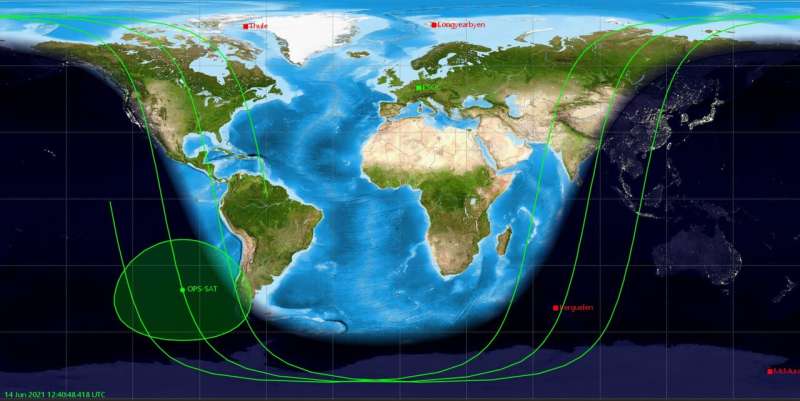Map showing the different reference station positions from which OPS-SAT received beacon transmissions. Credit: Tom Mladenov / JSatTrak
Between September 1982 and December 2020, at least 51,512 people were rescued on land and at sea with help from a network of Earth-orbiting satellites able to detect and locate emergency distress beacons.
ESA's OPS-SAT Space Lab recently demonstrated that by processing data from these beacons in space, instead of on Earth as currently happens, the whole process could be made more efficient, saving data and perhaps helping to save lives.
The humanitarian initiative in space
The international Cospas-Sarsat cooperative was established in 1979 and remains a fundamental, life-saving system. Using a network of instruments onboard more than 50 satellites, it detects emergency beacons from aircraft, ships and people anywhere on Earth, passing the coded information to ground stations to be processed and then forwarded to local Rescue Coordination Centres for a response.
Distress beacons are fundamentally radio transmitters that can be activated in emergencies, either manually by pressing a button or automatically upon detection certain triggers—a physical shock, contact with water, a sudden drop in altitude etc.
The Cospas-Sarsat system detects radio transmissions in the protected 406-MHz frequency band, gathering information on the type of vessel in distress and relaying its signals to ground stations on Earth known as Local User Terminals (LUTs). While some beacons contain the location of the vessel in question, many don't, and for these ground stations must perform a mathematical analysis to determine the location of the beacon.
Many satellites in low, medium and Geostationary orbit carry 'repeater instruments' which shift the frequency of the 406 MHz beacon transmissions to a different frequency in order to avoid interference with the original transmissions. The so-called 'upconverted' signals are sent to User Terminals where they are processed and decoded.
Once verified, beacon information is forwarded to the nearest Rescue Coordination Centre.
ESA's Space Lab: Decoding signals in orbit
ESA's OPS-SAT Space Lab is an orbiting Cubesat, open for experimentation. It carries a very powerful on-board computer and the ability to reconfigure its firmware in space. It was created with the specific intention of testing new mission control abilities in orbit, something too risky to be attempted on pre-existing, expensive satellites.
In a recent "In Orbit Demonstration," OPS-SAT performed the first in-orbit decoding and processing of radio-signals from emergency beacons on Earth, using open-source software running on the satellite.
The small but powerful satellite successfully detected and decoded 'reference beacons'—periodic bursts emitted by ground stations in the Cospas-Sarsat network to monitor the system's performance. The difference? OPS-SAT transmitted only the necessary information contained in the beacons down to ESA's Mission Control in Darmstadt, Germany.
Direct processing of distress beacons in space means the spacecraft only needs to send specific beacon signals back to the ground, rather than continuous recordings of the original raw signals (often empty as beacon transmissions are sporadic). The result? Far more efficient communications.
Why this matters
First and foremost, this experiment shows that when spacecraft carry powerful on-board computers, they are able to efficiently takeover some of the 'thinking' that is currently done on the ground. When they are not only acting as forwarding devices, picking up data and passing it on to more able people or machines on the ground, they can play a vital role in directly turning complex signals into actionable information. This successful demonstration clears the path for many future nanosatellites to join the current larger missions providing this essential service.
More broadly, when satellites are designed to be flexible, they can be configured to best suit the evolving needs of the societies beneath them. This will be especially important as we enter the era of the "Internet of Things' – when the physical objects around us are connected to each other via the internet, creating a wide network of technologies able to connect and exchange data with implications for our homes, healthcare systems and even industry and global infrastructures.
OPS-SAT's future
OPS-SAT is the first of its kind—a space mission open for the public to use to test their experiments in space.
"I first proposed investigating if OPS-SAT's on-board 'Software Designed Radio' (SDR) and antenna were sensitive enough to receive search and rescue signals even though it was not designed to do so," explains Tom Mladenov, experimenter responsible for this in-orbit demonstration, as well as member of the OPS-SAT Flight Control Team.
"Once it was confirmed that we could detect the faint transmissions on-board I used 'GNU Radio' to build the signal processing system that would run on the satellite. GNU Radio is a free and open-source library that breaks down complex signal processing systems into simple blocks. The ability to reprogram the SDR payload for any type of signal demonstrates the versatility when open-source software is combined with a powerful space platform such as OPS-SAT."
Already, dozens of experiments have taken place demonstrating how clever computers in orbit can use deep learning to help identify fires on Earth, automate collision predictions and now improve efficiency in relaying details of people in distress.
Coming up, a multitude more experiments pushing the boundaries of what satellites can do in orbit, for the benefit of people on Earth.
Provided by European Space Agency
























